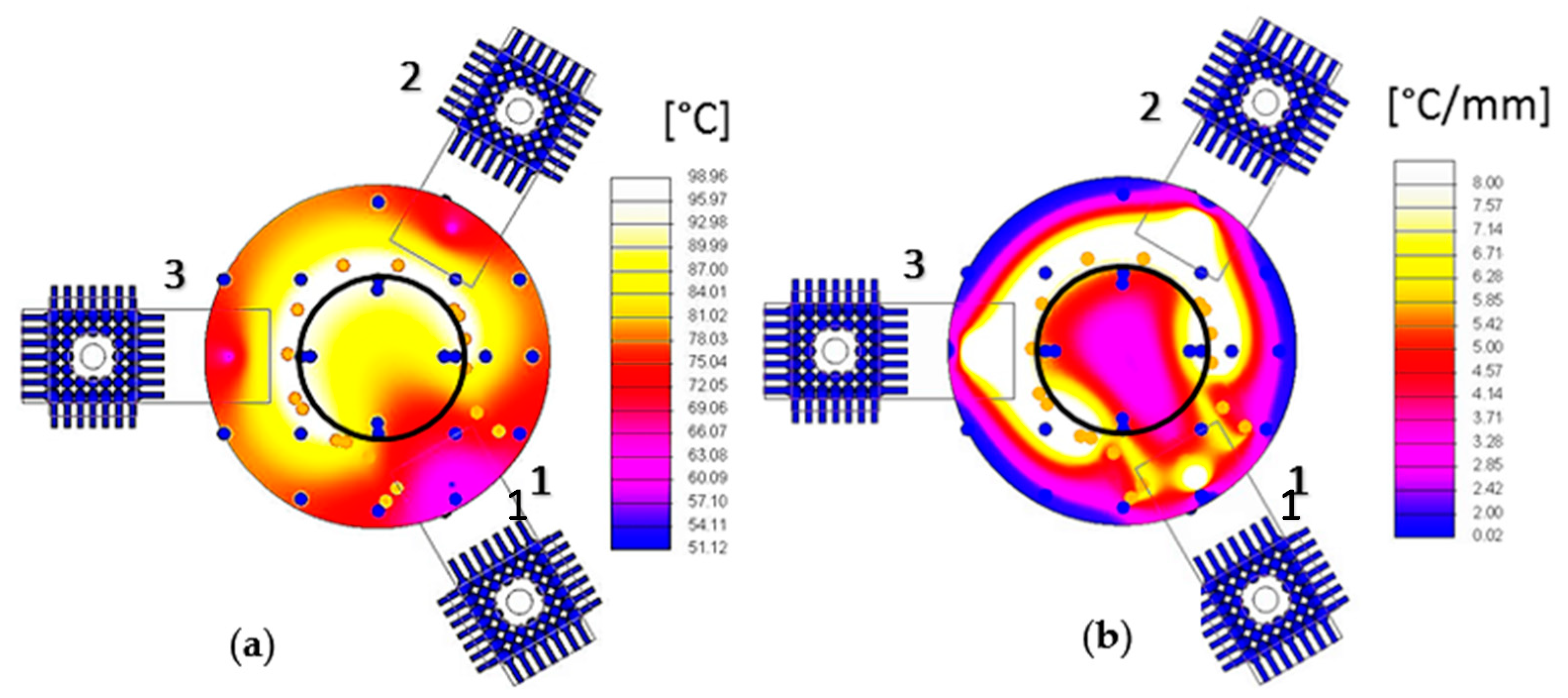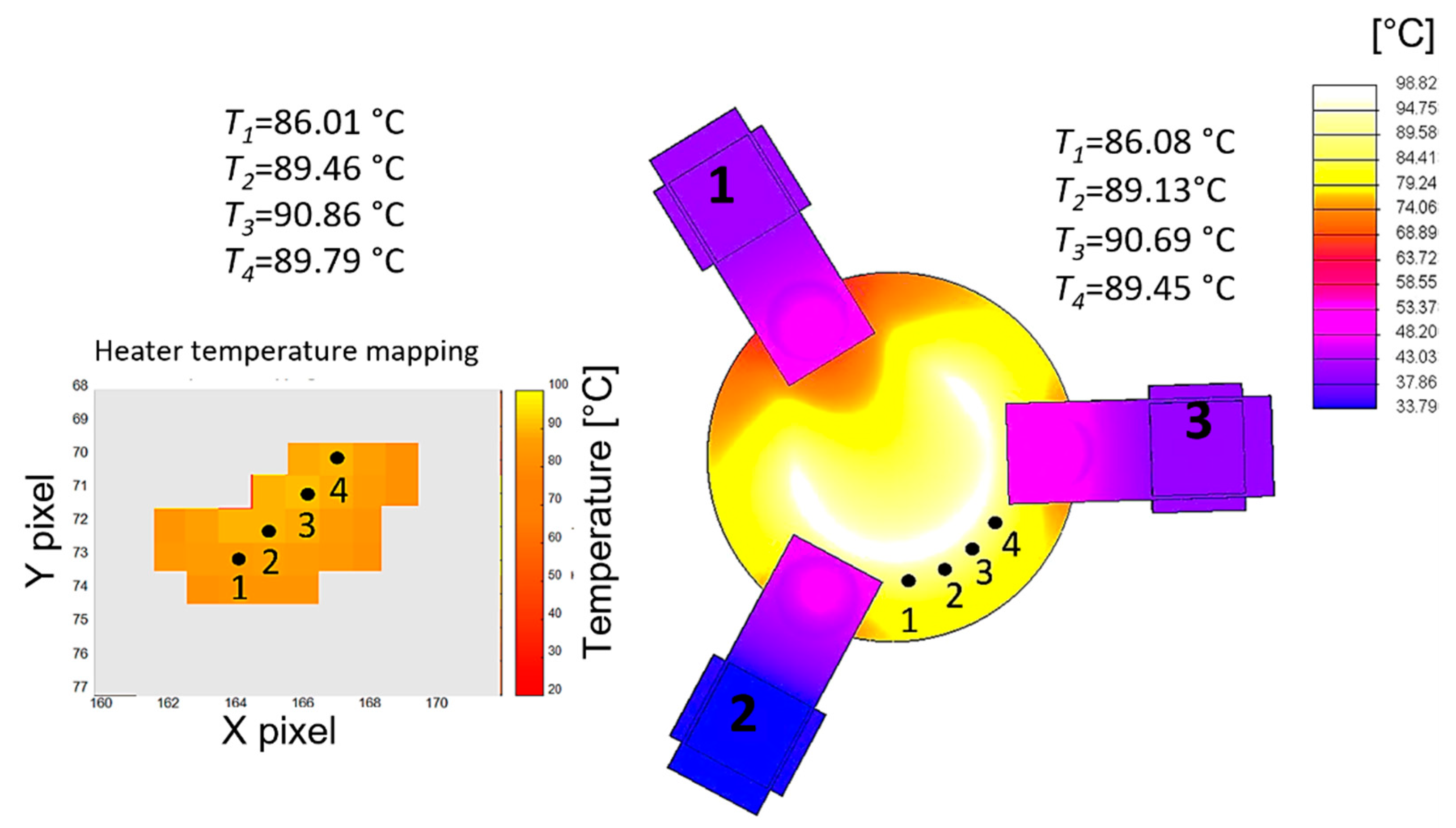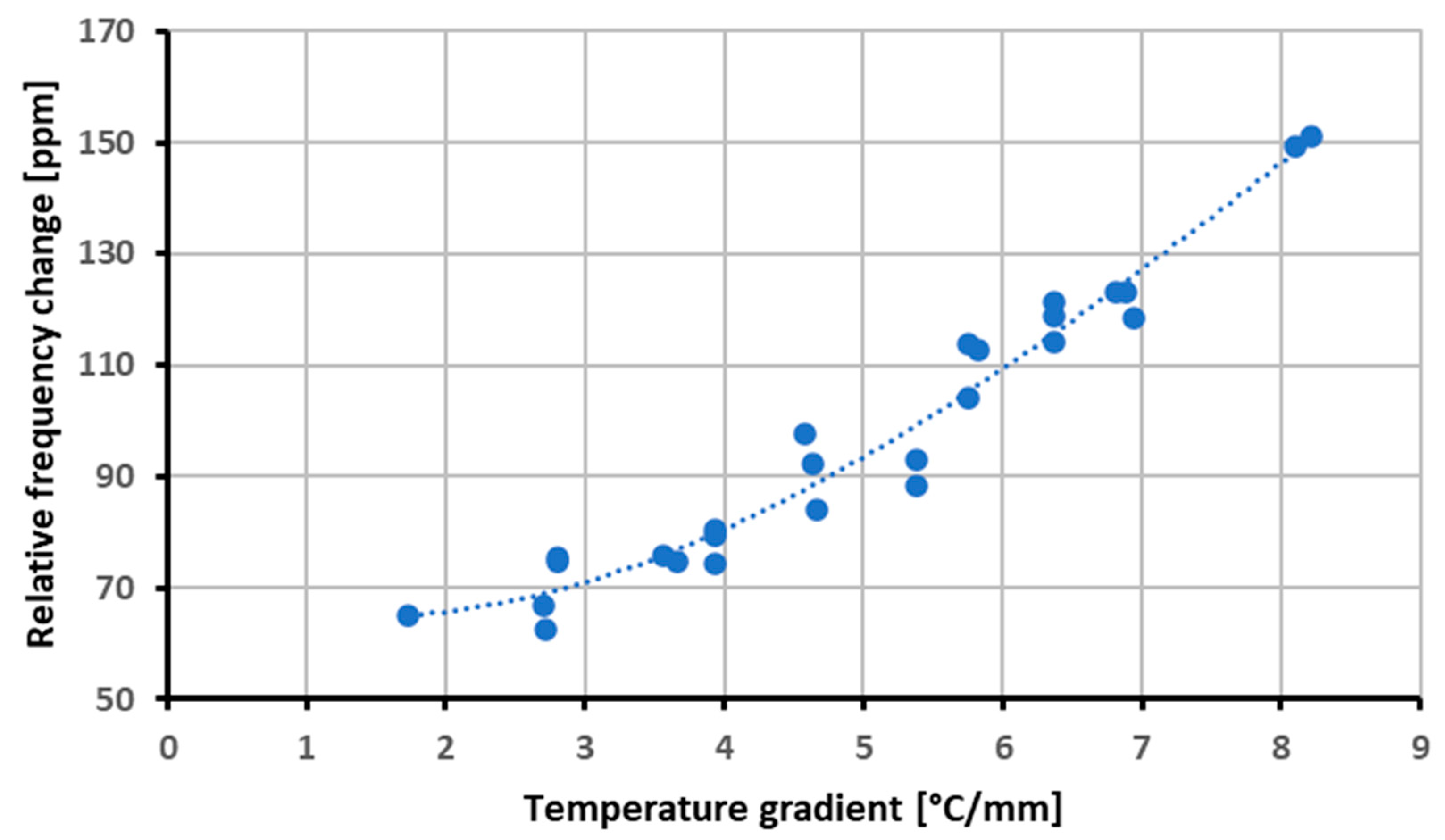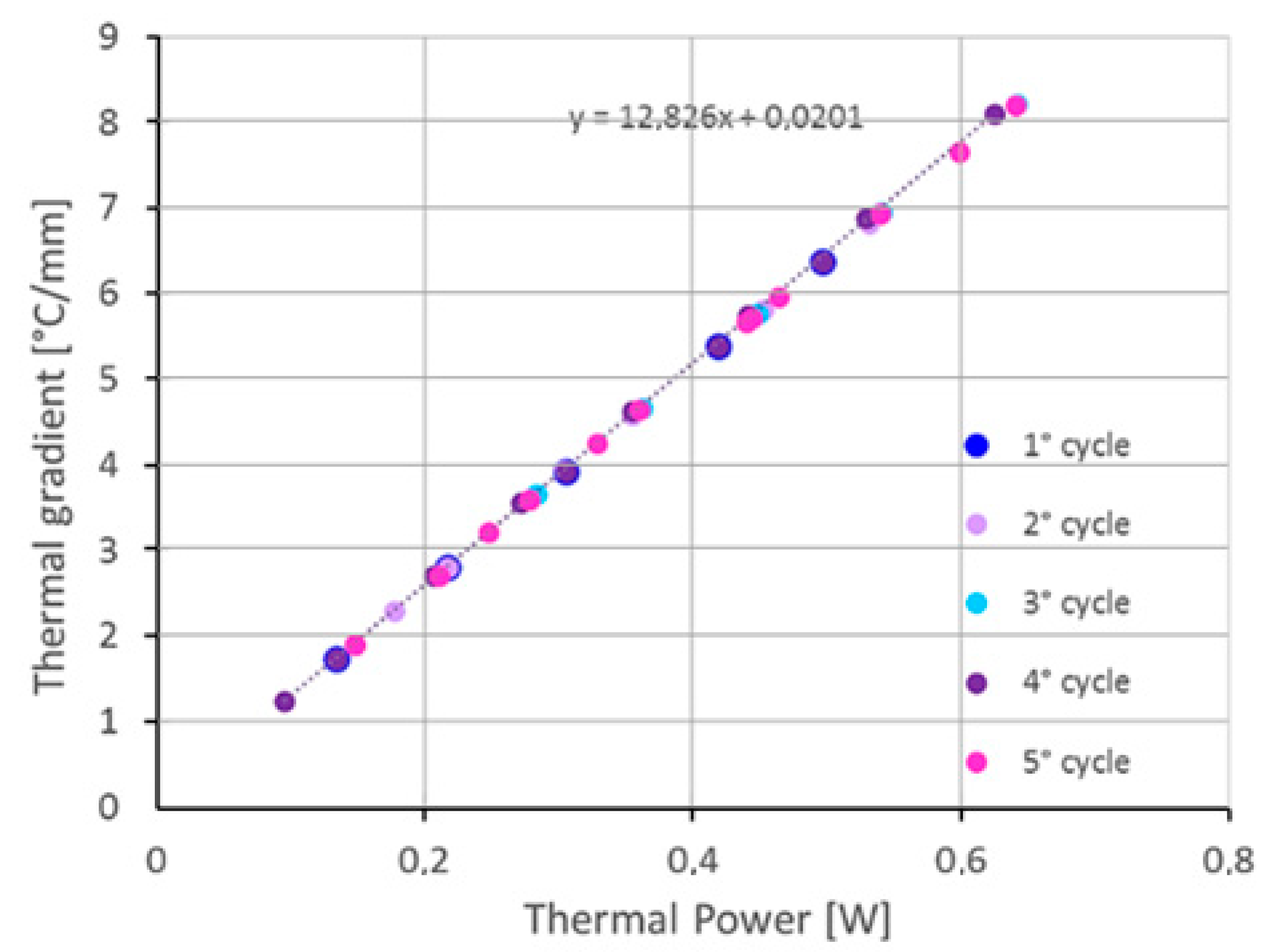Compensation of Thermal Gradients Effects on a Quartz Crystal Microbalance
Abstract
:1. Introduction
2. Temperature Gradient Determination from the Thermal Model
2.1. Analysis Conditions
2.2. Boundary Conditions
2.3. Results
2.4. Model Validation
3. Temperature Gradient Sensitivity
4. Conclusions
Author Contributions
Funding
Conflicts of Interest
References
- Wallace, D.A.; Wallace, S.A. Realistic performance specifications for flight quartz crystal microbalance instruments for contamination measurement on spacecraft. In Proceedings of the AIAA 23rd Thermophysics, Plasmadynamics and Lasers Conference, San Antonio, CA, USA, 27–29 June 1988. [Google Scholar]
- Wallace, D.A. Performance of a flight qualified, thermoelectrically temperature controlled QCM sensor with power supply, thermal controller and signal processor. In Proceedings of the NASA Conference Publication, Hampton, VI, USA, 5–7 November 1980; pp. 257–268. [Google Scholar]
- Yan, W.; Zhang, D.; Liu, X.; Chen, X.; Yang, C.; Kang, Z. Guar Gum/Ethyl Cellulose-Polyvinyl Pyrrolidone Composite-Based Quartz Crystal Microbalance Humidity Sensor for Human Respiration Monitoring. ACS Appl. Mater. Interfaces 2022, 14, 31343–31353. [Google Scholar] [CrossRef] [PubMed]
- Yamaguchi, T.; Matsuoka, T. Measurement of complex shear viscosity up to 3 GHz using an electrodeless AT-cut quartz transducer. Jpn. J. Appl. Phys. 2022, 61, SG1021. [Google Scholar] [CrossRef]
- Kumar, A.; Prajesh, R. The potential of acoustic wave devices for gas sensing applications. Sens. Actuators A Phys. 2022, 339, 113498. [Google Scholar] [CrossRef]
- Zhang, D.; Kang, Z.; Liu, X.; Guo, J.; Yang, Y. Highly sensitive ammonia sensor based on PSS doped ZIF-8-derived porous carbon/polyaniline hybrid film coated on quartz crystal microbalance. Sens. Actuators B Chem. 2022, 357, 131419. [Google Scholar] [CrossRef]
- Johnson, W.L.; Mansfield, E. Thermogravimetric analysis with a heated quartz crystal microbalance. In Proceedings of the 2012 IEEE International Frequency Control Symposium Proceedings (IFCS 2012), Baltimore, MD, USA, 21–24 May 2012; pp. 609–613. [Google Scholar]
- Dirri, F.; Palomba, E.; Longobardo, A.; Biondi, D.; Boccaccini, A.; Galiano, A.; Zampetti, E.; Saggin, B.; Scaccabarozzi, D.; Martin-Torres, J. VISTA Instrument: A PCM-Based sensor for organics and volatiles characterization by using thermogravimetric technique. In Proceedings of the 5th IEEE International Workshop on Metrology for AeroSpace, MetroAeroSpace 2018-Proceedings, Rome, Italy, 20–22 June 2018; pp. 150–154. [Google Scholar]
- Mason, W.P. Low Temperature Coefficient Quartz Crystals. Bell Labs Tech. J. 1940, 19, 74–93. [Google Scholar] [CrossRef]
- Mason, W.P.; Sykes, R.A. Low-Frequency Quartz-Crystal Cuts Having Low Temperature Coefficients. Proc. IRE 1944, 32, 208–215. [Google Scholar] [CrossRef]
- Tsuchiya, Y.; Kukita, H.; Shiobara, T.; Yukumatsu, K.; Miyazaki, E. Temperature Controllable QCM Sensor with Accurate Temperature Measurement for Outgas and Contamination Assessment. In Proceedings of the IEEE Sensors, Montreal, QC, Canada, 27–30 October 2019. [Google Scholar]
- Scaccabarozzi, D.; Saggin, B.; Tarabini, M.; Palomba, E.; Longobardo, A.; Zampetti, E. Thermo-mechanical design and testing of a microbalance for space applications. Adv. Space Res. 2014, 54, 2386–2397. [Google Scholar] [CrossRef]
- Valentin, J.P.; Theobald, G.; Gagnepain, J.J. Frequency Shifts Arising from in-Plane Temperature Gradient Distribution in Quartz Resonators. In Proceedings of the Annual IEEE International Frequency Control Symposium, Philadelphia, PA, USA, 29 May–1 June 1984; pp. 157–163. [Google Scholar]
- Valentin, J.P.; Théobald, G.; Gagnepain, J.J. Temperature-induced frequency shifts in quartz resonators. J. Appl. Phys. 1985, 58, 1388–1396. [Google Scholar] [CrossRef]
- Sinha, B.K. On the Interaction of Temperature Gradients with Surface Wave Propagation in Anisotropic Solids. IEEE Trans. Sonics Ultrason. 1985, 32, 583–591. [Google Scholar] [CrossRef]
- Li, N.; Meng, X.; Nie, J.; Lin, L. A QCM Dew Point Sensor With Active Temperature Control Using Thermally Conductive Electrodes. IEEE Sens. J. 2018, 18, 5715–5722. [Google Scholar] [CrossRef]
- Magni, M.; Scaccabarozzi, D.; Palomba, E.; Zampetti, E.; Saggin, B. Characterization of Thermal Gradient Effects on a Quartz Crystal Microbalance. Sensors 2022, 22, 7256. [Google Scholar] [CrossRef] [PubMed]
- Gibert, B.; Mainprice, D. Effect of crystal preferred orientations on the thermal diffusivity of quartz polycrystalline aggregates at high temperature. Tectonophysics 2009, 465, 150–163. [Google Scholar] [CrossRef]
- Rohsenow, W.R.; Hartnett, J.P.; Cho, Y.I. Handbook of Heat Transfer; McGraw Hill: New York, NY, USA, 1998. [Google Scholar]













| Components | Density | Young Modulus | Poisson Coefficient | CTE | Thermal Conductivity |
|---|---|---|---|---|---|
| [kg/m3] | [MPa] | [1/°C] | [W/(m °C)] | ||
| QUARTZ | 2649 | 76,500 | 0.17 | 7.10 × 10−6 | 6.2 |
| AISI316 | 8000 | 193,000 | 0.29 | 1.60 × 10−5 | 14 |
| MACOR | 2520 | 66,900 | 0.29 | 9.00 × 10−6 | 1.5 |
| Electrode Points | Error [°C] | Heater Points | Error [°C] |
|---|---|---|---|
| 1 | 1 | 1 | −0.07 |
| 2 | −0.5 | 2 | 0.33 |
| 3 | 0.2 | 3 | 0.17 |
| 4 | 0 | 4 | 0.34 |
| 5 | 0.4 |
Disclaimer/Publisher’s Note: The statements, opinions and data contained in all publications are solely those of the individual author(s) and contributor(s) and not of MDPI and/or the editor(s). MDPI and/or the editor(s) disclaim responsibility for any injury to people or property resulting from any ideas, methods, instructions or products referred to in the content. |
© 2022 by the authors. Licensee MDPI, Basel, Switzerland. This article is an open access article distributed under the terms and conditions of the Creative Commons Attribution (CC BY) license (https://creativecommons.org/licenses/by/4.0/).
Share and Cite
Magni, M.; Scaccabarozzi, D.; Saggin, B. Compensation of Thermal Gradients Effects on a Quartz Crystal Microbalance. Sensors 2023, 23, 24. https://doi.org/10.3390/s23010024
Magni M, Scaccabarozzi D, Saggin B. Compensation of Thermal Gradients Effects on a Quartz Crystal Microbalance. Sensors. 2023; 23(1):24. https://doi.org/10.3390/s23010024
Chicago/Turabian StyleMagni, Marianna, Diego Scaccabarozzi, and Bortolino Saggin. 2023. "Compensation of Thermal Gradients Effects on a Quartz Crystal Microbalance" Sensors 23, no. 1: 24. https://doi.org/10.3390/s23010024





